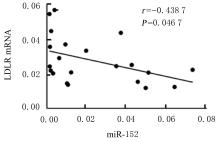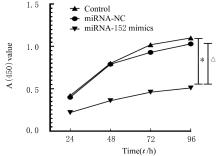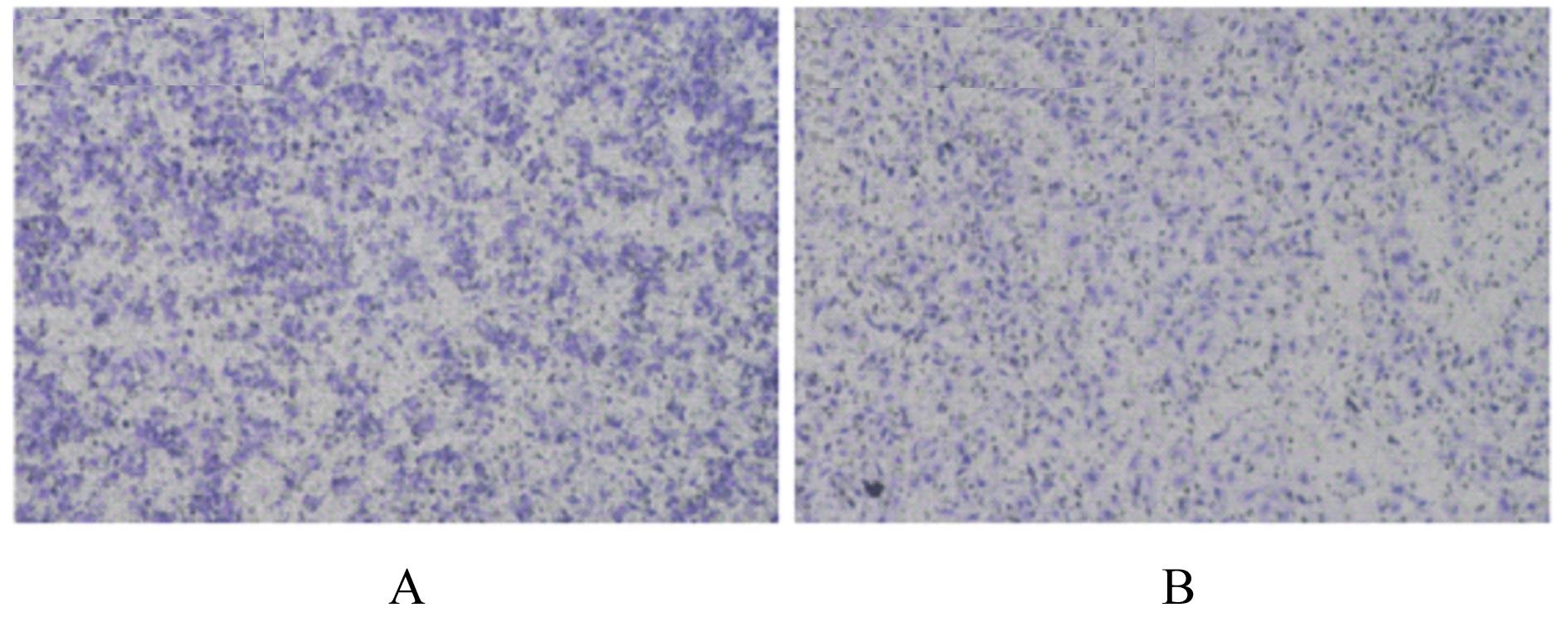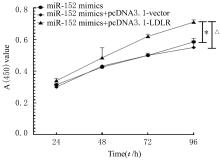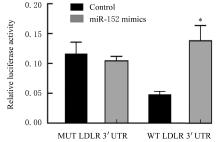吉林大学学报(医学版) ›› 2022, Vol. 48 ›› Issue (3): 591-599.doi: 10.13481/j.1671-587X.20220306
• 基础研究 • 上一篇
miR-152降低低密度脂蛋白受体表达对子宫内膜癌细胞增殖和侵袭的抑制作用
- 1.石河子大学医学院第一附属医院妇产科,新疆 石河子 832000
2.四川省遂宁市中心医院妇科,四川 遂宁 629000
3.新疆维吾尔自治区石河子市人民医院妇科,新疆 石河子 832000
4.南方医科大学第五附属医院妇科,广东 广州 510900
Inhibitory effect of miR-152 on proliferation and invasion of endometrial carcinoma cells by reducing low-density lipoprotein receptor expression
Guowu WANG1,2,Yuan YAO1,Yu ZHANG3,Na XU1,Fang LIU2,4( )
)
- 1.Department of Obstetrics and Gynecology,First Affiliated Hospital,School of Medical Sciences,Shihezi University,Shihezi 832000,China
2.Department of Gynecology,Central Hospital,Suining City,Sichuan Province,Suining 629000,China
3.Department of Gynecology,People’s Hospital,Shihezi City,Xinjiang Uygur Autonomous Region,Shihezi 832000,China
4.Department of Gynecology,Fifth Affiliated Hospital,Southern Medical University,Guangzhou 510900,China
摘要: 探讨微小RNA-152(miR-152)在子宫内膜癌(EC)组织中的表达和作用,为研究EC的发病机制和靶向治疗方案提供依据。 选取21例EC患者癌组织(肿瘤组)和39例非EC患者内膜组织(对照组)及人EC RL95-2细胞和293T细胞为研究对象。收集肿瘤组和对照组患者的年龄、身高、体质量(BM)、体质量指数(BMI)、收缩压(SBP)、舒张压(DBP)、腰围(WC)和腹围(AC)等临床资料,检测2组患者甘油三酯(TG)、总胆固醇(TC)、低密度脂蛋白(LDL)、高密度脂蛋白(HDL)、Ki-67和低密度脂蛋白受体(LDLR)水平,生物信息学方法预测miR-152下游与增殖和侵袭相关的靶基因LDLR表达,实时荧光定量PCR(RT-qPCR)法检测肿瘤组和对照组患者子宫内膜组织中miR-152表达水平,Western blotting法和免疫组织化学检测法检测肿瘤组和对照组患者子宫内膜组织中LDLR 蛋白表达水平,Person相关分析法分析LDLR mRNA表达与患者一般资料、生化指标及miR-152表达的相关性。将RL95-2细胞分为空质粒组(转染miR-NC 空质粒)、miR-152组(转染miR-152-mimics)、miR-152-mimics+pcDNA3.1-vector组(同时转染miR-152-mimics和pcDNA3.1-vector) 和miR-152-mimics+pcDNA3.1-LDLR 组(同时转染miR-152-mimics和 pcDNA3.1-LDLR)。CCK-8法检测各组细胞增殖率,Transwell法检测各组细胞的侵袭细胞数,双荧光素酶报告基因实验检测各组293T细胞中荧光素酶活性。 肿瘤组患者子宫内膜组织中miR-152表达水平明显低于对照组(P<0.05),LDLR mRNA和蛋白表达水平均高于对照组(P<0.05 或P<0.01)。双荧光素酶报告基因检测,LDLR为 miR-152的靶基因。Person相关分析,肿瘤组患者子宫内膜组织中LDLR mRNA表达与Ki-67、BMI、TC、TG、BM和WC呈正相关关系(r=0.4490, r=0.4377, r=0.4472, r=0.4706, r=0.5882, r=0.5130, P<0.05),与miR-152的表达呈负相关关系(r=-0.4378,P<0.05)。与空质粒组比较,miR-152组RL95-2细胞增殖率降低(P<0.05),侵袭细胞数减少(P<0.05);与miR-NC组比较,miR-152组RL95-2细胞增殖率降低(P<0.05),侵袭细胞数减少(P<0.05);与miR-152-mimics+pcDNA3.1-vector组比较,miR-152-mimics+pcDNA3.1-LDLR组细胞增殖率升高(P<0.01),侵袭细胞数增多(P<0.01)。 miR-152通过降低LDLR的表达抑制EC细胞增殖和侵袭。
中图分类号:
- R737.33






